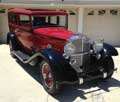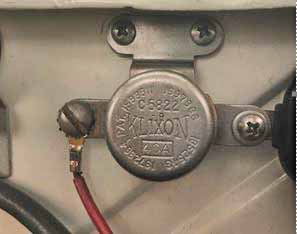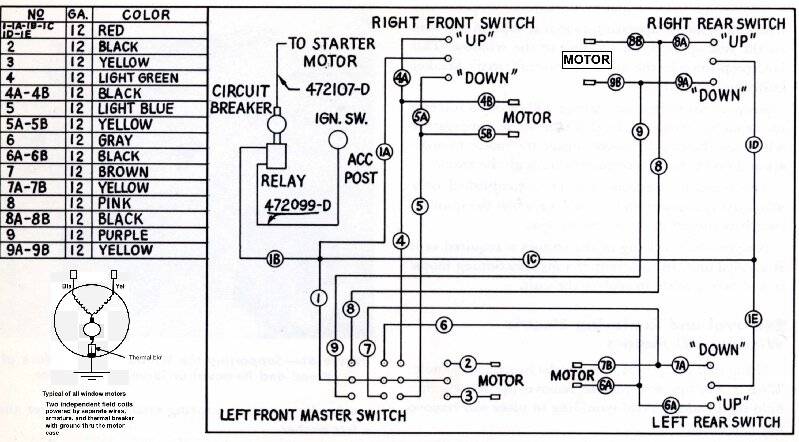|
Re: '55 Caribbean Power Windows
|
||||
|---|---|---|---|---|
|
Home away from home

|
Quote:
... I also want to thank you for developing this marvel challenge... A sacrilege! Marty, is -> this perhaps what you're looking for?
Posted on: 2023/9/23 1:26
|
|||
|
The story of ZIS-110, ZIS-115, ZIL-111 & Chaika GAZ-13 on www.guscha.de
|
||||
|
||||
|
Re: '55 Caribbean Power Windows
|
||||
|---|---|---|---|---|
|
Home away from home

|
Thanks Howard sorry I didn't make my a post a little clearer. I was referring to the one in Post #5 in this thread. I have the electrical schematic.
What I've discovered so far is the "Down Wire" on the electric motor shorted out against the motor's body. When the driver's side switch stuck in the down position it continued to provide current to the motor. This caused the wire from the Lift Relay to the Ignition Switch (ACC position) to go through a melt down of it's insulation. Luckily the only damage was to that single run of wire. I was somewhat perplexed as to why the Circuit Breaker didn't protect the circuitry. It appears that the melted wire is 14 gauge. I would have thought it should have been 12 gauge. Any thoughts on should the wire being 12 G as I'm getting ready to replace it this afternoon? ADDED EDIT. Looked at the amp rating on the breaker and discovered it is for 40A. Doesn't make sense the heaviest wire in/out is only 12 G, which is 20A or less. Attach file:  40A Circuit Breaker.JPG (30.78 KB) 40A Circuit Breaker.JPG (30.78 KB)
Posted on: 2023/9/23 13:57
|
|||
|
||||
|
Re: '55 Caribbean Power Windows
|
||||
|---|---|---|---|---|
|
Home away from home
|
I was looking in the documentation and was unable to find info on what rating the breaker should be. Perhaps someone else can look at theirs.
We tend to think of 12ga wire as 20 amp but automotive wire is usually 105C rated (because engine heat) and that would handle probably 35 amps safely. I suspect the circuit breaker itself malfunctioned from age/corrosion. If it already seems toast, maybe pry it open and take a look at the internal condition. If you are rewiring I would upsize the wire to 10awg (because why not) and put a fuse or second circuit breaker in line (30-40 amps). I wouldn't trust the factory breaker after what happened.
Posted on: 2023/9/23 14:57
|
|||
|
1955 400 | Registry | Project Blog
1955 Clipper Deluxe | Registry | Project Blog 1955 Clipper Super Panama | Registry Email (Parts/service inquiries only, please. Post all questions on the forum.) service@ultramatic.info |
||||
|
||||
|
Re: '55 Caribbean Power Windows
|
||||
|---|---|---|---|---|
|
Forum Ambassador
|
The wire from the ign switch is a 14 or 16 ga control wire and should not have been affected because of the switch and motor issue. Its only duty is to turn on the relay and the only way it should have been able to be damaged is if the relay or wire itself shorted. It almost sounds as if there is a miswire and someone powered the windows directly from the ign sw by using the control wire for power and bypassing the relay. That is a huge load on a small wire and an ign switch that is marginally sized under the best of normal conditions.
Power for all the windows, power seat and if installed, the power door locks comes directly from the BAT terminal on starter solenoid via a red #12 wire. That wire connects to one end of the circuit breaker and I believe they chose 40 amps for the breaker because it is conceivable two or more motors could be going at the same time. The other end of the circuit breaker goes to one of the contact terminals on the normally open relay. The other contact terminal out of the relay feeds a #12 wire with continuing splices to the various window switches. The power seat feed wire is also 12ga and would also be connected on that same relay out terminal.
Posted on: 2023/9/23 15:14
|
|||
|
Howard
|
||||
|
||||
|
Re: '55 Caribbean Power Windows
|
||||
|---|---|---|---|---|
|
Home away from home

|
Howard your writeup in #15 was excellent and spot on.
When I started looking into the wiring I found one wire (red 12G) connected to the circuit breaker with it’s output being connected to the input of the relay (terminal #1) 12G . On the relay there were two wires (a red 12G and black 14G) connected to terminal #2 (output from relay) and two wires on terminal 3 (both red a 12G and 14G). On the relay the red 12G on terminal #2 went to the power seats. On terminal #2 haven’t figured out what the 14G black wire is for yet). On terminal #3 the 14G wire (that melted) went to the ACC on the ignition switch and the red 12G went to power the windows, which explains why the 14 g wire failed. The red 12G should have been on terminal #2 and not #3. I think the 40A circuit breaker and relay setup was Packard engineer’s work around for not putting another possible 40A draw on an already over taxed ign. Switch. I think they should have put two places in the fuse box for the PS and PW with 20A each.
Posted on: 2023/9/25 12:29
|
|||
|
||||
|
Re: '55 Caribbean Power Windows
|
||||
|---|---|---|---|---|
|
Forum Ambassador
|
Not disagreeing with your comment on needing more fuses. Not really sure how other mfgs did it at the time but I don't think electrical and fuses - or lack thereof - was ever Packards strong point. Probably a holdover from earlier times when they provided one or two fuses as being enough for the whole car.
Guess we should be glad they had any kind of protection. 55 was the first year they actually provided a centralized fuse holder and that only had the bare minimum complement of mostly low amp items safely fed directly from the ign switch. Any of the more modern accessories needing higher amperage such as windows, seats, AC, overdrive, Electric Shift, Torsion level were still powered directly from the battery via relays and inline fuses or breakers. Not sure a multitude of fuses would help either because even with the minimal amount of protection Packard did provide, as you and others have found out it is still obviously too easy for someone to screw up or bypass what little is there.
Posted on: 2023/9/25 13:51
|
|||
|
Howard
|
||||
|
||||
|
Re: '55 Caribbean Power Windows
|
||||
|---|---|---|---|---|
|
Home away from home

|
Howard an interest bit of info I found on this site Electric Window Motor Circuit Breaker Installation.
Also, I'm still looking for the entire diagram of the hardware linkage that was posted in #5.
Posted on: 2023/9/25 17:06
|
|||
|
||||
|
Re: '55 Caribbean Power Windows
|
||||
|---|---|---|---|---|
|
Forum Ambassador
|
The extra breaker was needed when replacement Leece-Neville motors were installed. Stude offered that motor in 1960 as a service part when supply of the original Delcos ran out. The added breaker is because the replacement motors did not have the internal breaker.
The partial diagram in post 5 is from plate 20E of the 55-6 parts manual.
Posted on: 2023/9/25 18:09
|
|||
|
Howard
|
||||
|
||||
|
Re: '55 Caribbean Power Windows
|
||||
|---|---|---|---|---|
|
Home away from home

|
It turns out that the clip, mentioned in Post #5 was not where the red arrow points was, but at the long end of the arm. With the window all the way up it was impossible to reach and I couldn’t get to it from the top. So I unclipped the two other arms and only with great difficulty was able to reach the one on the long arm. With some struggling I got the PW motor out of the door.
Opening up the motor in an attempt to replace the frayed wires, I discovered the field on one side was fried. I have another motor on the way. I have also reconnected the other two arms to the window and I’m pondering the best way the reconnect the long arm once I get the replacement. Any ideas or suggestions would be appreciated and welcomed.
Posted on: 2023/9/28 20:09
|
|||
|
||||









